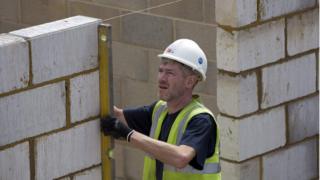Planning law overhaul for England takes next step
 Image copyright Reuters
Image copyright Reuters Sweeping changes to England’s planning system will «cut red tape, but not standards,» Housing Secretary Robert Jenrick has said.
Under draft new laws, first revealed on Sunday, developers will be granted «automatic» permission to build homes and schools on sites for «growth».
It follows Boris Johnson’s pledge to «build back better» after coronavirus.
But critics warn it could lead to «bad-quality housing» and loss of local control over development.
Mr Johnson promised to speed up investment into homes and infrastructure in June to help the UK recover from the economic impact of coronavirus.
But Labour’s shadow housing and planning minister, Mike Amesbury, said the new plan was a «developer’s charter that will see communities side-lined in decisions and denied vital funding for building schools, clinics and community infrastructure».
The government’s planning white paper, which goes out to consultation on Thursday, contains wide-ranging measures aimed at speeding up house building.
The changes are expected to only impact England, as planning policy is devolved to the administrations in Scotland, Wales and Northern Ireland.
Mr Jenrick said: «Our complex planning system has been a barrier to building the homes people need.
«These once in a generation reforms will lay the foundations for a brighter future, providing more homes for young people and creating better quality neighbourhoods and homes across the country.
«Planning decisions will be simple and transparent, with local democracy at the heart of the process.»
But the chairman of the Local Government Association, James Jamieson, said the idea that planning was a barrier to house building was «a myth».
From planning to building
Mr Jamieson claimed that nine in 10 planning applications were approved by councils, and more than a million homes given permission in the last decade had yet to be built.
Homeless charity Shelter said 280,000 homes received permission in England between 2011 and 2016 but were never built.
BBC Reality Check said there had been criticism in recent years of the amount of time it takes to get planning permission – but it also noted many developers secure planning permission and then do not immediately build.
Planning rows raise high passions.
For Jacky Nabb, a proposal to build 3,000 houses near her home in the Oxfordshire countryside felt to her like «somebody just twisted my stomach».
She added: «It sounds really dramatic, but it broke my heart».
The has been a four-year battle over the prospective new town at Chalgrove – and a broader plan for local homes – with bitter political skirmishing and the personal intervention of the housing secretary.
But still, not a single brick has been laid here.
It is exactly this sort of delay ministers want to sweep away.
Under their policy, once a local plan is agreed, developers in some places could press on with confidence.
But local Conservatives have opposed the Chalgrove plan too, just as they have many other developments.
Will the government hold firm should campaigning Tories – under fire from home-owning voters – turn on this policy?
Making yet another announcement about homes is easy. Turning it into real change will require political courage.
A number of new planning measures were announced by the government in June.
From September, home owners will be allowed to build above their properties without going through the normal planning process and developers will be able build above – or demolish and rebuild – vacant premises, or change the use of a town centre shops, without planning permission.
Builders will also be allowed to convert a wider range of commercial properties into homes – despite criticism in a government-commissioned report that the existing policy has led to poor quality, cramped flats with low quality of life for their residents.
New proposals, revealed by Mr Jenrick on Sunday, are now being put forward by the government in a white paper, including:
- Designating land into three categories – «growth», «renewal» or «protected» – affecting the level of planning permission needed
- A fast-track planning system for «beautiful buildings»
- New online planning proposals so that local communities «will be consulted from the very beginning of the planning process»
- All new streets will have to be tree-lined
- Making all councils have a local plan for housing
The plans also include the «first homes scheme», to provide newly-built homes at a 30% per cent discount for local people, key workers and first-time buyers.
And the government will introduce a new national charge for developers – replacing the existing Section 106 agreements and the Community Infrastructure Levy – to fund projects such as schools, roads and GP surgeries.
But the chief executive of the National Housing Federation, Kate Henderson, said Section 106 agreements are «the single biggest contribution to building new affordable homes in the country», as they require private developers to build a certain amount of social homes in every new development.
She said: «Any alternative to Section 106 must ensure we can deliver more high quality affordable homes to meet the huge demand across the country.»
A spokeswoman for the Ministry of Housing, Communities and Local Government said the new levy would «aim to at least maintain revenue levels nationally when compared to the current system, and to ensure that delivery of affordable housing on-site is maintained, to create mixed and balanced communities».
‘Make a bad situation much worse’
The government will also pledge in the white paper to make all new homes carbon neutral by 2050, stopping all new buildings from needing retrofitting.
The Wildlife Trusts said, while there were «fundamental flaws» in current planning rules, the new laws around «growth», «renewal» and «protected» areas would «make a bad situation much worse».
The charity group’s director of campaigning and policy, Nikki Williams, said: «The government may find it inconvenient that wildlife won’t stick to its three categories and survives outside protected areas, as well as thriving on some brownfield sites that it would like to see developed.
«Local authorities will have to be far better resourced with access to high-quality ecological data.»
It’s hard to be sure about these proposals from the environmental perspective because key details are missing.
One policy unifies green critics – the plan to make all homes carbon neutral by 2050.
Labour promised to achieve that by 2016, and environmentalists condemned the later date as «pitiful».
They also fear the zoning system will do little to help the wildlife that lives outside protected areas.
The current system governed by councillors is very flexible. The zoning system would be more rigid.
Apart from that, confusion abounds.
What happens, for instance, if citizens devising their local plan decide their whole area should fall into the «protection» category? Can they reject all new homes on their patch?
If so, what’s the role of the government’s housing targets?
Perhaps answers will emerge.
But I’m told some officials in the department think these plans have been rushed and are rather a «dog’s dinner».
The UK’s planning system was effectively established in 1947, two years after the end of the war, with the Town and Country Planning Act.
The Conservative Party has repeatedly pledged to «build and fund» 40 new or rebuilt NHS hospitals before 2029, while the PM has promised the «most radical reforms» of the planning system since World War Two.


